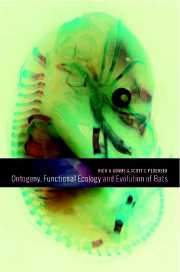Book contents
- Frontmatter
- Contents
- List of contributors
- 1 Integrating ontogeny into ecological and evolutionary investigations
- 2 Bat phylogeny: an evolutionary context for comparative studies
- 3 Early embryology, fetal membranes, and placentation
- 4 Brain ontogeny and ecomorphology in bats
- 5 Evolutionary plasticity and ontogeny of the bat cochlea
- 6 Skull growth and the acoustical axis of the head in bats
- 7 Ontogeny of the chiropteran basicranium, with reference to the Indian false vampire bat, Megaderma lyra
- 8 A theoretical consideration of dental morphology, ontogeny, and evolution in bats
- 9 Wing ontogeny, shifting niche dimensions, and adaptive landscapes
- 10 Ontogeny and evolution of the hindlimb and calcar: assessing phylogenetic trends
- 11 A comparative perspective on the ontogeny of flight muscles in bats
- 12 The ontogeny of behavior in bats: a functional perspective
- Index
11 - A comparative perspective on the ontogeny of flight muscles in bats
Published online by Cambridge University Press: 17 August 2009
- Frontmatter
- Contents
- List of contributors
- 1 Integrating ontogeny into ecological and evolutionary investigations
- 2 Bat phylogeny: an evolutionary context for comparative studies
- 3 Early embryology, fetal membranes, and placentation
- 4 Brain ontogeny and ecomorphology in bats
- 5 Evolutionary plasticity and ontogeny of the bat cochlea
- 6 Skull growth and the acoustical axis of the head in bats
- 7 Ontogeny of the chiropteran basicranium, with reference to the Indian false vampire bat, Megaderma lyra
- 8 A theoretical consideration of dental morphology, ontogeny, and evolution in bats
- 9 Wing ontogeny, shifting niche dimensions, and adaptive landscapes
- 10 Ontogeny and evolution of the hindlimb and calcar: assessing phylogenetic trends
- 11 A comparative perspective on the ontogeny of flight muscles in bats
- 12 The ontogeny of behavior in bats: a functional perspective
- Index
Summary
INTRODUCTION
Flight muscles, and the pectoralis muscle in particular, are the ‘motors’ behind flight in bats. Whereas the locomotory muscles of most mammals are composed of multiple fiber types (discussed below) which facilitate different kinds of movements (slow versus fast movements, for example), the flight muscles of several bats have been classified as either unitypic or bitypic (Hermanson & Foehring 1988; Hermanson 1998). For example, in the unitypic condition, the pectoralis muscle is made of only a single (fast-twitch) fiber type and is highly specialized for a specific pattern of contraction. In contrast, bats with bitypic muscles have pectoralis muscles containing two fiber types which are both presumably fasttwitch, but which probably differ in underlying metabolic specializations. These observations about the pectoralis can be extended to other muscles in the shoulder girdle, most notably the serratus anterior (‘serratus ventralis’ of Nomina Anatomica Veterinaria 1994), subscapularis, and short head of biceps brachii. Inclusion of these muscles as primary downstroke muscles was hypothesized by Vaughan (1959) based on his careful dissection studies of bats, and was substantiated by histochemical (Foehring & Hermanson 1984; Hermanson & Foehring 1988; and others) and electromyographic studies of these muscles (Hermanson & Altenbach 1981, 1985; Altenbach & Hermanson 1987). Most studies of bat flight muscles and anatomy were based on analysis of adult specimens. Thus, it is not surprising that we have learned little about the normal ontogeny of bat muscles and about the problems faced by growing bats, nor about the comparative ecology of juvenile bats from different chiropteran species.
A large body of literature exists about the normal ontogeny of locomotory muscles of terrestrial mammals.
- Type
- Chapter
- Information
- Ontogeny, Functional Ecology, and Evolution of Bats , pp. 333 - 361Publisher: Cambridge University PressPrint publication year: 2000
- 3
- Cited by



